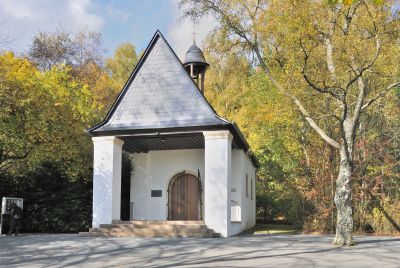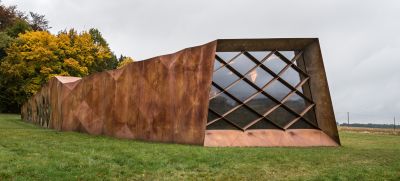Polish victims in the Hinzert SS concentration camp

Also among the prisoners were approximately 100 Jews, as well as Sinti and Roma, who had been deported to Hinzert mainly for political rather than racist reasons. Around a third of the Jewish prisoners were murdered in the most brutal way, while in the case of the Sinti and Roma, there is clear evidence of just one murder of a Roma prisoner.[1] One of the Jews brought to Hinzert was Aron Silberstein, born in 1895 in Weislitz in the district of Petrikau (Piotrków). He was classified as stateless and lived in Luxembourg City during the 1940s. Silberstein was forced to work on the construction of the Reichsautobahn near Wittlich. On 25 February 1942, he was arrested for not wearing a “Judenstern” (yellow Star of David badge). On 10 March, he was transported to Hinzert. After spending two months in the Hinzert SS special camp/concentration camp, he was transferred by the SS to Buchenwald concentration camp, where he was murdered on 28 May 1942. His son Adolf (b. 1928) was deported to the Izbica concentration camp (voivodeship of Lublin) in April 1942.[5] His wife Esther died in the Theresienstadt camp in July 1943. Nothing is known of the fate of his two daughters, who were taken to Theresienstadt in May 1944 aged ten and twelve, and who from there were transferred to an unknown camp.[6]
In July 1941, Reichsführer-SS Heinrich Himmler changed the procedure regarding the threat of punishment, through to punishment by death, of Polish forced labourers accused of committing offences. The penalty was now to be preceded by a “racial assessment”. The goal was to determine any possible “Wiedereindeutschungsfähigkeit” (“potential for re-germanisation”). The aim from the perspective of the National Socialists was to retain as many forced labourers as possible.[7] The overriding ideological and racial goal was a “desired increase in the population” for the German “Volkskörper” (“racial corpus”), while at the same time removing the “racially valuable families” from the elites of the “ethnic Polish race”.[8] The Hinzert SS special camp/concentration camp was the central facility within the National Socialist camp system for the “germanisation” of Polish men.
However, like many other forced labourers from western and eastern Europe, Poles were also brought to Hinzert for reasons other than “re-germanisation”. Stanislaus Kowalski, born in Hörde near Dortmund in 1912, was taken to the “work education camp” in Hinzert. He and his parents were “Ruhr Poles”. His family returned to his parents’ homeland, to Wielkopolska (Greater Poland), where Kowalski’s last place of abode before he was arrested was in the district of Śrem. He was married and had a child who was born around 1936. Several months after the occupation of Poland, at the end of May 1940, under circumstances that are not known, he was brought to the Else II mine owned by the Anhaltische Kohlenwerke AG group in Mücheln, to the south-west of Halle on the Saale river. From September 1940, he worked as a forced labourer on several farms in the west of the Reich. In November 1942, unable to bear the heavy work far away from his family, he escaped from his last place of work in Bad Kreuznach. Soon afterwards, he was seized and taken to the Gestapo headquarters in Koblenz, and from there, on 17 December 1942, to the “work education camp” in Hinzert. On 25 January 1943, he was transferred from Hinzert to Natzweiler, where he arrived in a very poor state of health. Even so, he was only admitted to the prisoners’ hospital barracks over a week later, on 3 February. He died there on 5 February 1943.[9]
[5] Bader, Uwe; Welter, Beate: Das SS-Sonderlager/KZ Hinzert, in: Benz, Wolfgang; Distel, Barbara (eds.): Der Ort des Terrors. Geschichte der nationalsozialistischen Konzentrationslager . Vol. 5: Hinzert, Auschwitz, Neuengamme, München 2007, p. 17–74, here p. 24.
[6] The town of Izbica, which was to a large extent inhabited by Jews, and which became a ghetto, was used as a transit camp for the death camps in Bełżec, Sobibór and Treblinka.
[7] Hinzert SS special camp/concentration camp memorial site, permanent exhibition.
[8] Klormann, Felix: “Eindeutschungs-Polen” im SS-Sonderlager/Konzentrationslager Hinzert, in: Grotum, Thomas (ed.), Die Gestapo Trier. Beiträge zur Geschichte einer regionalen Verfolgungsbehörde, Cologne et al 2018, p. 115–128, here p. 115–117.
[9] Letter from the Reichsführer SS to the higher-ranking SS and police leaders dated 3/7/1940, with the order regarding the deployment of Poles with the potential for germanisation, in: United States Holocaust Memorial Museum (USHMM), RG-15.015 M, 259, quoted in: Heinemann, Isabel: Rasse, Siedlung, deutsches Blut. Das Rasse- und Siedlungshauptamt der SS und die rassenpolitische Neuordnung Europas, Göttingen 2003, p. 282.
[10] See Hennig, Joachim: Stanislaus Kowalski. “Tod durch Abgang!” (Konzentrationslager Natzweiler-Struthof), who researched and publicised the fate of Stanislaus Kowalski. https://mahnmalkoblenz.de/index.php/2013-12-12-02-07-02/die-personentafeln/230-088-stanislaus-kowalski-aus-grosspolen-in-bad-kreuznach (12/1/2022). The locations involved in Kowalski’s story could be identified from a series of documents in the online archive of the International Tracing Service (ITS) Arolsen. See e.g. the camp doctor at Natzweiler concentration camp to the concentration camp political division, “Tod des Polen Nr. 2280 Kowalski, Stanislaus”, Natzweiler 5/2/1943, in: ITS Online Archives 01012902 oS/Dok. 3190270.









